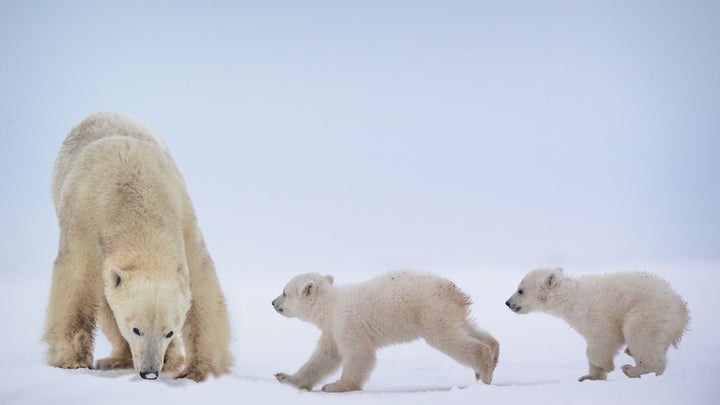
If we truly care about polar bears and the world we are leaving for future generations, we must continue to follow the path outlined in the Paris Climate Agreement.
When people learn I study polar bears, the first question they usually ask is, “Are they really in trouble?” The short answer is yes—and International Polar Bear Day is a fitting time to remind everyone about why the polar bear’s future truly is in jeopardy, and what we must do about it.
Simply put, it’s all about sea ice.
Polar bears can reliably catch their main prey, ringed and bearded seals, only from the surface of the sea ice. Satellite images show us that sea ice has been decreasing for over 30 years, and has been at record lows across the Arctic this winter.
Because the polar bear’s sea ice habitat literally melts as temperatures rise, the relationship between warmer temperatures and fewer polar bears is straightforward. What many don’t understand is that the laws of physics dictate that our planet’s temperatures must increase as long as we continue to add CO2 and other greenhouse gases to our atmosphere—just as the law of gravity dictates that when you drop a ball it will hit the floor.
Earth’s climate depends on the balance between incoming and outgoing energy. The shortwave radiation coming in from the sun ultimately must be balanced by outgoing long-wave radiation emitted back into space. If the sun’s heat that reaches Earth was not re-radiated into space, our planet would long ago have been reduced to a ball of molten rock or hot gas. The magic of Earth’s atmosphere has been in relatively stable levels of naturally occurring CO2 and other greenhouse gases. These gases, which don’t impede the short-wave radiation coming in, temporarily capture the outgoing long-wave radiation before releasing that energy back into space. Natural levels of these gases have historically retained the sun’s energy for just the right amount of time to keep Earth’s temperatures suitable for life.
But, we are upsetting Earth’s natural balance by pumping billions of tons of CO2 and other greenhouse gases into the atmosphere each year. Every ton of coal we burn, for example, puts three and a half tons of CO2 into the air. The same physical laws that have maintained stable average temperatures and allowed us to thrive, also mean that rising concentrations of CO2—from burning fossil fuels—prolong retention of the sun’s heat before it escapes back into space. This longer heat retention requires Earth’s average temperature to increase. Denying that Earth’s average temperature must increase as CO2 levels rise would require a whole new explanation for why we have life on Earth!
Of course natural fluctuations in weather and climate will continue as always. The difference between near-term uncertainties caused by natural fluctuations in our weather, and the long-term certainty of a warming climate caused by increasing greenhouse gas concentrations, remains a source of confusion for many. That confusion is magnified because many people, including our policy leaders, have misled us by suggesting that a cold snap in Cleveland, or snow in Washington DC, is somehow inconsistent with the long-term trend of global warming. As Earth’s average temperature relentlessly rises, hot spells will become ever more common, as we already are seeing. But we will also continue to have local and regional “cold snaps,” although already, they are only half as common as they were just decades ago.
Natural variation surrounding the rising average temperature also creates uncertainty in exactly when particular events will occur. We cannot, for example, confidently predict the first year summer sea ice will disappear from the Arctic, or exactly when it will be too hot to grow wheat in Kansas. But, unabated greenhouse gas rise guarantees we ultimately will exceed both thresholds. Society’s challenge in dealing with human caused climate warming is to maintain focus on the ultimate certainty—that without stopping greenhouse gas rise, we will lose polar bears and exceed all of the other thresholds we care about.
The good news is that most of the uncertainty about future climate is in our hands. We cannot control the natural variation in the climate system, but we can control the slope of the rising baseline. We can stay on the current path and let our climate continue to warm and change in ways that will negatively impact the lives of all future generations. Or ideally, we can choose a path, like that outlined at the Paris Climate Talks in 2015, stopping the rise in greenhouse gas concentrations, and bringing us to a new level baseline. Taking the path outlined in Paris could avoid the worst that future global warming has to offer.
We understand the role of greenhouse gases on our atmosphere as well as we understand the impact of gravity—both are controlled by the same laws of physics. Every time we stumble, we are reminded of the “law” of gravity. Although the consequences of ignoring an ever-warming world will be far more severe than falling down the stairs, many of our policy leaders continue to deny the impact of greenhouse gases on our climate. Today, International Polar Bear Day, is a reminder for everyone who genuinely cares about the world we are leaving for future generations, to push for the United States, and all nations, to continue following the path outlined in the Paris Climate Agreement. Doing so will assure a future for polar bears and far fewer “stumbles” in the pathway we leave for our children.
Join us: Given how much is at stake, it’s more important than ever that we let our leaders know we care about this issue. Please sign our pledge to become an engaged citizen, speaking up for bold action on climate—on International Polar Bear Day and every day. By signing, we’ll be able to send you action alerts and other ways to get involved. Together, we can show strength in numbers and effect positive change—for polar bears, people, and the planet.
